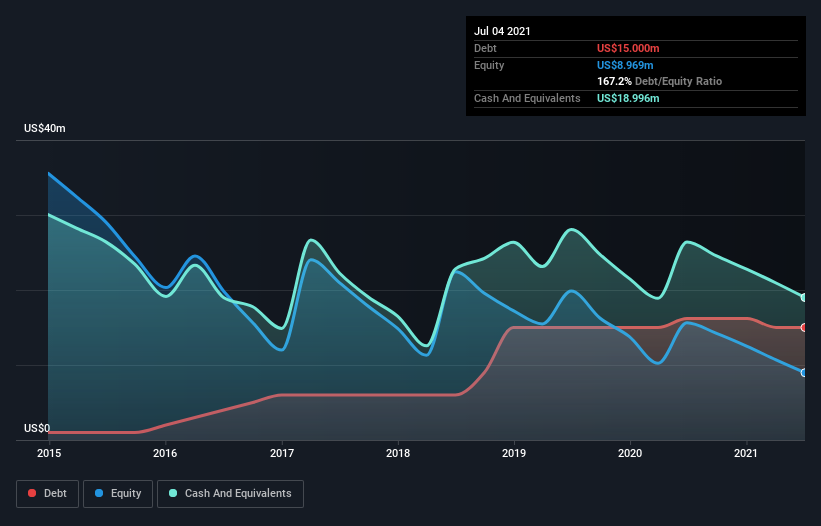Is QuickLogic (NASDAQ:QUIK) Using Too Much Debt?
David Iben put it well when he said, 'Volatility is not a risk we care about. What we care about is avoiding the permanent loss of capital.' When we think about how risky a company is, we always like to look at its use of debt, since debt overload can lead to ruin. We can see that QuickLogic Corporation (NASDAQ:QUIK) does use debt in its business. But is this debt a concern to shareholders?
When Is Debt A Problem?
Debt and other liabilities become risky for a business when it cannot easily fulfill those obligations, either with free cash flow or by raising capital at an attractive price. If things get really bad, the lenders can take control of the business. However, a more common (but still painful) scenario is that it has to raise new equity capital at a low price, thus permanently diluting shareholders. Of course, the upside of debt is that it often represents cheap capital, especially when it replaces dilution in a company with the ability to reinvest at high rates of return. When we examine debt levels, we first consider both cash and debt levels, together.
View our latest analysis for QuickLogic
What Is QuickLogic's Net Debt?
You can click the graphic below for the historical numbers, but it shows that QuickLogic had US$15.0m of debt in July 2021, down from US$16.2m, one year before. However, its balance sheet shows it holds US$19.0m in cash, so it actually has US$4.00m net cash.
How Healthy Is QuickLogic's Balance Sheet?
The latest balance sheet data shows that QuickLogic had liabilities of US$18.7m due within a year, and liabilities of US$1.07m falling due after that. Offsetting this, it had US$19.0m in cash and US$2.06m in receivables that were due within 12 months. So it can boast US$1.31m more liquid assets than total liabilities.
This state of affairs indicates that QuickLogic's balance sheet looks quite solid, as its total liabilities are just about equal to its liquid assets. So it's very unlikely that the US$80.5m company is short on cash, but still worth keeping an eye on the balance sheet. Simply put, the fact that QuickLogic has more cash than debt is arguably a good indication that it can manage its debt safely. The balance sheet is clearly the area to focus on when you are analysing debt. But ultimately the future profitability of the business will decide if QuickLogic can strengthen its balance sheet over time. So if you're focused on the future you can check out this free report showing analyst profit forecasts.
Over 12 months, QuickLogic saw its revenue hold pretty steady, and it did not report positive earnings before interest and tax. While that's not too bad, we'd prefer see growth.
So How Risky Is QuickLogic?
We have no doubt that loss making companies are, in general, riskier than profitable ones. And in the last year QuickLogic had an earnings before interest and tax (EBIT) loss, truth be told. And over the same period it saw negative free cash outflow of US$7.0m and booked a US$8.8m accounting loss. However, it has net cash of US$4.00m, so it has a bit of time before it will need more capital. Overall, its balance sheet doesn't seem overly risky, at the moment, but we're always cautious until we see the positive free cash flow. The balance sheet is clearly the area to focus on when you are analysing debt. However, not all investment risk resides within the balance sheet - far from it. We've identified 4 warning signs with QuickLogic , and understanding them should be part of your investment process.
Of course, if you're the type of investor who prefers buying stocks without the burden of debt, then don't hesitate to discover our exclusive list of net cash growth stocks, today.
This article by Simply Wall St is general in nature. We provide commentary based on historical data and analyst forecasts only using an unbiased methodology and our articles are not intended to be financial advice. It does not constitute a recommendation to buy or sell any stock, and does not take account of your objectives, or your financial situation. We aim to bring you long-term focused analysis driven by fundamental data. Note that our analysis may not factor in the latest price-sensitive company announcements or qualitative material. Simply Wall St has no position in any stocks mentioned.
Have feedback on this article? Concerned about the content? Get in touch with us directly. Alternatively, email editorial-team (at) simplywallst.com.

 Yahoo Finance
Yahoo Finance 
